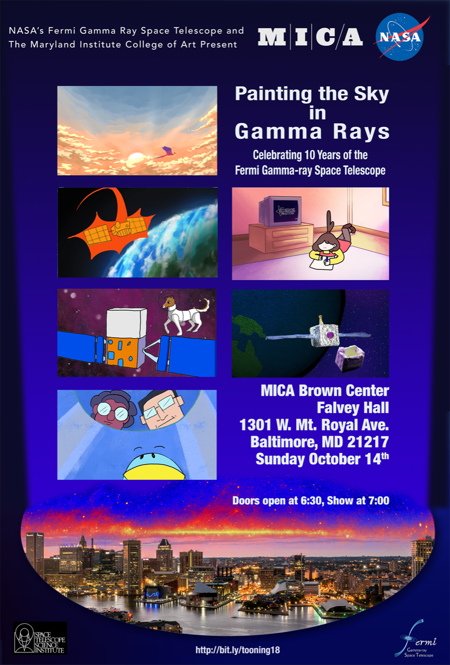Eighth International Fermi Symposium
» Conference Photo (Credit: NASA/GSFC, Jay Friedlander)
Thank you for attending this symposium and making it a success. Almost all talks and posters are available from the Program page where they are linked to the author's name.
Date: Oct 14-19, 2018
Location: Baltimore, MD
Important Dates
2018 July 16 - Open Registration & Abstract Submission
2018 Aug 24 - Abstract Deadline (Hard Deadline for Oral Contributions)
2018 Sep 07 - Preliminary Program Announced
2018 Sep 14 - Early Registration Ends
2018 Oct 10 - Hotel Group Rates End (Note extended deadline!)
2018 Oct 01 - Poster Abstract Deadline
2018 Oct 11 - Regular Registration Ends (Late/Onsite Registration is available)
2018 Oct 14-19 - Symposium (Sunday evening through Friday noon)
Overview
This symposium follows previous Fermi Symposia at Stanford, CA (February 2007), Washington, DC (November 2009), Rome, Italy (May 2011), Monterey, CA (November 2012), Nagoya, Japan (October 2014), Arlington, VA (November 2015), and Garmisch-Partenkirchen, Germany (October 2017).
The two Fermi instruments have been surveying the high-energy sky since August 2008. The Large Area Telescope (LAT) has discovered more than a thousand new sources and many new source classes, bringing the importance of gamma-ray astrophysics to an ever-broadening community. The LAT catalog includes supernova remnants, pulsar wind nebulae, pulsars, binary systems, novae, several classes of active galaxies, starburst galaxies, normal galaxies, and a large number of unidentified sources. Continuous monitoring of the high-energy gamma-ray sky has uncovered numerous outbursts from a wide range of transients. Fermi LAT's study of diffuse gamma-ray emission in our galaxy revealed giant bubbles shining in gamma rays. The direct measurement of a harder-than-expected cosmic-ray electron spectrum may imply the presence of nearby cosmic-ray accelerators. LAT data have provided stringent constraints on new phenomena such as supersymmetric dark-matter annihilations as well as tests of fundamental physics. The Gamma-ray Burst Monitor (GBM) continues to be a prolific detector of gamma-ray transients: magnetars, solar flares, terrestrial gamma-ray flashes and gamma-ray bursts at keV to MeV energies, complementing the higher energy LAT observations of those sources in addition to providing valuable science return in their own right.
All gamma-ray data are made immediately available at the Fermi Science Support Center. These publicly available data and Fermi analysis tools have enabled a large number of important studies. We especially encourage guest investigators worldwide to participate in this symposium to share results and to learn about upcoming opportunities.
This meeting will focus on the new scientific investigations and results enabled by Fermi, the mission and instrument characteristics, future opportunities, and coordinated observations and analyses.
Public Event
 Painting the Sky in Gamma Rays: Celebrating 10 Years of Discoveries from the Fermi Gamma-ray Space Telescope
Painting the Sky in Gamma Rays: Celebrating 10 Years of Discoveries from the Fermi Gamma-ray Space Telescope
Maryland Institute College of Art (MICA)
Brown Center, Falvey Hall
1301 W Mt Royal Ave, Baltimore, MD 21217
Program
Welcome Reception
Monday, Oct 15, 5:30-6:30 on the Terrace.
Banquet
Join us for a delightful dinner cruise on the Spirit of Baltimore. Delicious food with panoramic views of the skyline. Boarding starts at 6:30pm and we depart at 7pm. Click here for additional tickets.
Please see the allergen chart for the food options at banquet dinner.
Hotel Information
The 8th Fermi Symposium will be held at the Sheraton Inner Harbor Hotel, 300 South Charles Street, Baltimore, MD 21201, United States, Phone: (1)(410) 962-8300
Hotel bookings at the conference group rates can be made here until 10 Oct 2018. Later bookings must be made directly with the hotels.
Organizing Committees
Contact
- Questions? Email the organizers at: fermisymposium2018@bigbang.gsfc.nasa.gov



